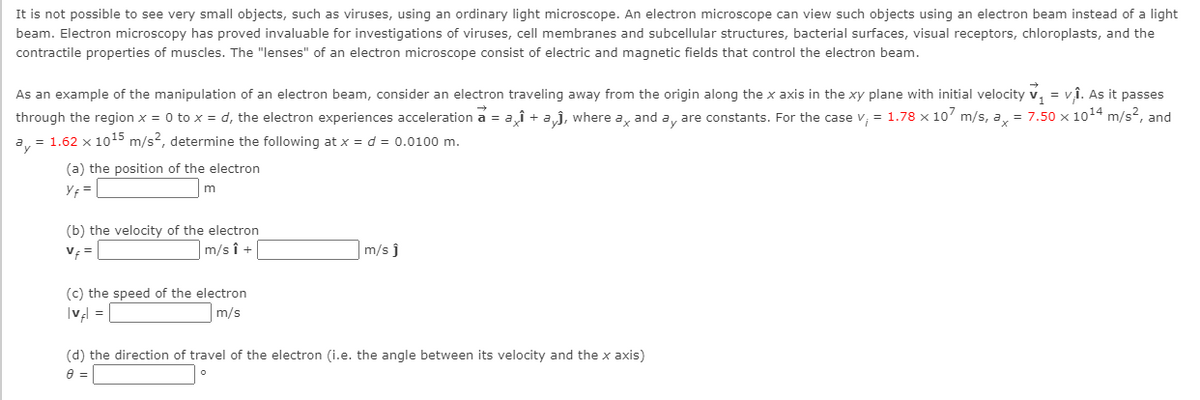As an example of the manipulation of an electron beam, consider an electron traveling away from the origin along the x axis in the xy plane with initial velocity v, = vî. As it passes through the region x = 0 to x = d, the electron experiences acceleration a = ai + aj, where a, and a, are constants. For the case v, = 1.78 x 10' m/s, a, = 7.50 x 1014 m/s², and a, = 1.62 x 1015 m/s?, determine the following at x = d = 0.0100 m. (a) the position of the electron
As an example of the manipulation of an electron beam, consider an electron traveling away from the origin along the x axis in the xy plane with initial velocity v, = vî. As it passes through the region x = 0 to x = d, the electron experiences acceleration a = ai + aj, where a, and a, are constants. For the case v, = 1.78 x 10' m/s, a, = 7.50 x 1014 m/s², and a, = 1.62 x 1015 m/s?, determine the following at x = d = 0.0100 m. (a) the position of the electron
Principles of Physics: A Calculus-Based Text
5th Edition
ISBN:9781133104261
Author:Raymond A. Serway, John W. Jewett
Publisher:Raymond A. Serway, John W. Jewett
Chapter25: Reflection And Refraction Of Light
Section: Chapter Questions
Problem 5OQ: The index of refraction for water is about 43. What happens as a beam of light travels from air into...
Related questions
Question

Transcribed Image Text:It is not possible to see very small objects, such as viruses, using an ordinary light microscope. An electron microscope can view such objects using an electron beam instead of a light
beam. Electron microscopy has proved invaluable for investigations of viruses, cell membranes and subcellular structures, bacterial surfaces, visual receptors, chloroplasts, and the
contractile properties of muscles. The "lenses" of an electron microscope consist of electric and magnetic fields that control the electron beam.
As an example of the manipulation of an electron beam, consider an electron traveling away from the origin along the x axis in the xy plane with initial velocity v, = vị. As it passes
through the region x = 0 to x = d, the electron experiences acceleration a = aî + aj, where a, and a, are constants. For the case v, = 1.78 × 107 m/s, a, = 7.50 x 1014 m/s?, and
a, = 1.62 x 1015 m/s?, determine the following at x = d = 0.0100 m.
(a) the position of the electron
m
(b) the velocity of the electron
V =
m/s î +
m/s j
(c) the speed of the electron
|v = |
m/s
(d) the direction of travel of the electron (i.e. the angle between its velocity and the x axis)
Expert Solution
This question has been solved!
Explore an expertly crafted, step-by-step solution for a thorough understanding of key concepts.
This is a popular solution!
Trending now
This is a popular solution!
Step by step
Solved in 4 steps

Recommended textbooks for you

Principles of Physics: A Calculus-Based Text
Physics
ISBN:
9781133104261
Author:
Raymond A. Serway, John W. Jewett
Publisher:
Cengage Learning

Principles of Physics: A Calculus-Based Text
Physics
ISBN:
9781133104261
Author:
Raymond A. Serway, John W. Jewett
Publisher:
Cengage Learning